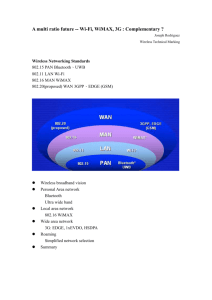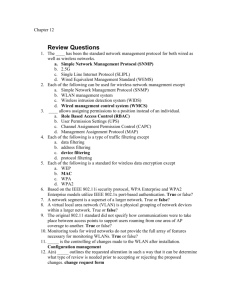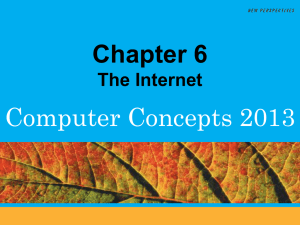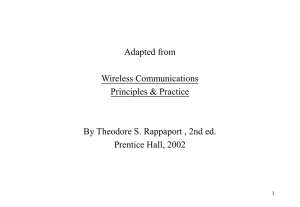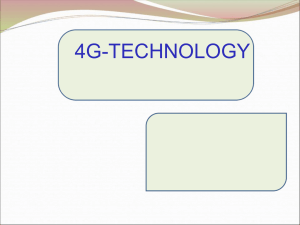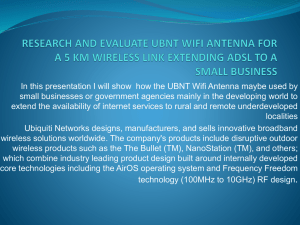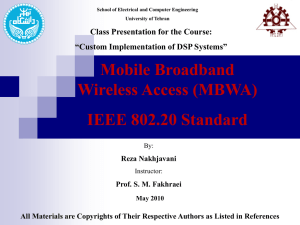Wireless MAN Technology and WiMAX (cont`d)
advertisement
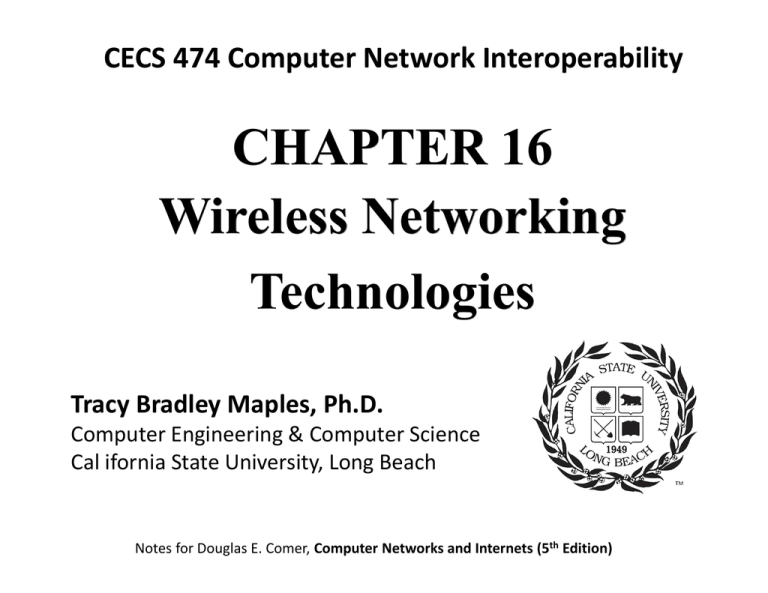
CECS 474 Computer Network Interoperability CHAPTER 16 Wireless Networking Technologies Tracy Bradley Maples, Ph.D. Computer Engineering & Computer Science Cal ifornia State University, Long Beach Notes for Douglas E. Comer, Computer Networks and Internets (5th Edition) Wireless Network Taxonomy • Wireless communication includes a wide range of network types and sizes. • Government regulations that make specific ranges of the electromagnetic spectrum available for communication • A license is required to operate transmission equipment in some parts of the spectrum and other parts of the spectrum are unlicensed Personal Area Networks (PANs) • A PAN technology provides communication over a short distance. • It is intended for use with devices that are owned and operated by a single user. • IEEE has assigned the number 802.15 to PAN standards. Bluetooth The IEEE 802.15.1a Standard evolved after vendors created Bluetooth technology as a short-distance wireless connection technology. The characteristics of the Bluetooth technology are: • Wireless replacement for cables (e.g., headphones or mouse) • Uses 2.4 GHz frequency band • Short distance (up to 5 meters, with variations up to 10 or 50 meters) • Device is either master or slave • Master grants permission to slave • Data rate is up to 721 Kbps Wireless LAN Standards (WiFi) Standards from the first years of WiFi: Wireless LAN Standards (WiFi) (cont’d) More recent WiFi standards: 802.11n – Standardized in 2009. -- Extends 802.11b and .11g -- Uses the 2.4 GHz and 5 GHz frequency bands -- Expected total multi-station throughput of 600 Mbps -- Uses MIMO (Multiple Input Multiple Output) by having multiple antennae at both sender and receiver -- Up to 4 more MIMO spatial streams 802.11ac – Preliminary versions now showing up in new WiFi Routers. -- WLANs on the 5 GHz frequency bands -- Final standard approval expected in early 2014 -- Expected total multi-station throughput of 1 Gbps; single link throughput 500 Mbps -- Extends 802.11n capabilities with: wider RF band & up to 8 MIMO spatial streams Wireless Local Area Network (WLAN) Architecture Note: The set of computers within range of a given access point is known as a Basic Service Set (BSS). RTS: Request to Send (frame sent to request communication and reserve channel) Contention and Contention-Free Access CTS: Clear to Send (frame sent confirming reserved channel) ACK: Acknowledgement DIFS: Distributed Interframe Space (enough time for the station to sense the medium to see that it is idle) SIFS: Short Interframe Space (enough time for the transmitting station to switch back to receive mode) Note: More on this will be discussed in the Wireless Supplement notes. Wireless MAN Technology and WiMAX Standardized by IEEE under the category IEEE 802.16. Two main versions of WiMAX are being developed that differ in their overall approach: Fixed WiMAX • refers to systems built using IEEE 802.16-2004 (informally called 802.16d) • does not provide for handoff among access points • provides connections between a service provider and a fixed location Mobile WiMAX • Standard 802.16e-2005 (informally called 802.16e) • handoffs among Aps • used for mobile hosts Wireless MAN Technology and WiMAX (cont’d) WiMAX offers broadband communication that can be used in a variety of ways: Wireless MAN Technology and WiMAX (cont’d) The key features of WiMAX can be summarized as follows: • Uses licensed spectrum (i.e., offered by carriers) • Each cell can cover a radius of 3 to 10 Km • Uses scalable orthogonal FDM • Guarantees quality of services (for voice or video) • Can transport 70 Mbps in each direction at short distances • Provides 10 Mbps over a long distance (10 Km) Cellular Communication Systems • When moving between two cells belonging to the same MSC the switching center handles the change. • When a user passes from one geographic region to another, MSCs are involved in the handoff. Cellular Communication Systems (cont’d) (a) Perfect cellular coverage occurs if each cell is a hexagon: • because the cells can be arranged in a honeycomb • in practice, cellular coverage is imperfect (b) Most cell towers use omnidirectional antennas: • transmit in a circular pattern • obstructions and electrical interference can attenuate a signal or cause an irregular pattern o in some cases, cells overlap and in others, gaps exist with no coverage Generations of Cellular Technologies Telecommunications industry divides cellular technologies into four generations: 1G, 2G, 3G, and 4G (with intermediate versions labeled 2.5G and 3.5G) Simplified Descriptions: 1G • Began in the late 1970s, and extended through the 1980s • Originally called cellular mobile radio telephones • used analog signals to carry voice 2G and 2.5G • Began in the early 1990s and continues to be used • One standard: GSM (General System for Communications) • The main distinction between 1G and 2G arises because 2G uses digital signals to carry voice • The label 2.5G is used for systems that extend a 2G system to include some 3G features Generations of Cellular Technologies (cont’d) 3G and 3.5G • Began in the 2000s • Focuses on the addition of higher-speed data services • A 3G system offers download rates of 400 Kbps to 2 Mbps, and is intended to support applications such as web browsing and photo sharing • Includes EDGE (Enhanced Data Rates for GSM Evolution) (amongst other approaches) • 3G allows a single telephone to roam across the world 4G and 4G LTE (Long Term Evolution) • Began around 2008 • Incompatible with 2G and 3G networks and must be implemented separatedly. • Based on GSM/EDGE • Focuses on support for real-time multimedia o such as a television program or high-speed video • They include multiple connection technologies o such as Wi-Fi and satellite o at any time, the phone automatically chooses the best connection technology available
